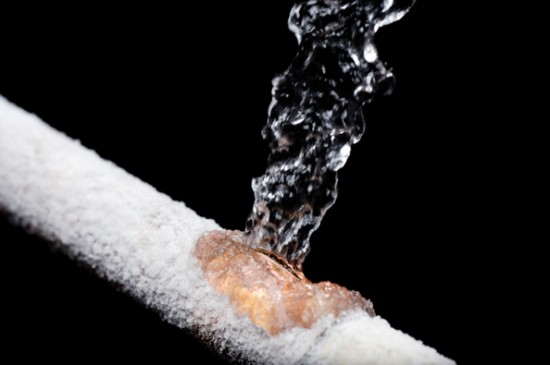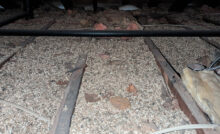Frozen Pipes – How To Prevent and Repair
Frozen Water Pipes
With temperatures dropping below zero here in the Northeast I thought it was fitting to write about Frozen Pipes. Each year thousands of homes are damaged by frozen water pipes. As ice expands inside of a water pipe it acts like an incredibly strong jack that causes most water pipes to burst resulting in damaging floods.
How To Prevent Frozen Water Pipes
Preventing frozen water pipes in your home should be a top priority if you live in a cold climate. Damage resulting from a frozen water pipe can cost hundreds to tens of thousands of dollars. Preventing your pipes from freezing isn’t that difficult if you know where the trouble spots might be located. The following are the most usual locations for frozen water pipes:
- Water pipes located inside of exterior walls. This is the most obvious problem location but one that is often unseen until it’s too late. While most builders avoid running water pipes in exterior walls there are situations that do require it. When this is necessary I recommend that the water pipes are wrapped in insulation and the space between the wall sheathing and water pipe be insulated with 2″ to 4″ of closed cell foam board insulation (like XPS).
- Water pipes located in crawl spaces. Another really bad location is in a crawl space with no heat. If water pipes are necessary in areas like this then they should be well insulated. It might also be necessary to use pipe heating tape or other supplemental heating to protect the pipes.
- Open Faucet To A Slow Drip. If you have a water pipe in one of the “danger zones” that can’t be safe-guarded then you might be able to prevent the frozen pipe by opening the faucet or valve slightly. This allows water to slowly move through the pipe preventing it from freezing. Obviously this is quite wasteful and only an option of last resort.
- Seal Holes In Foundations and Walls. Another cause of frozen pipes is due to holes in your foundation or walls. If you have holes that allow cold drafts to blow against water pipes they are likely to freeze when the temperatures fall below 20 degrees F.
How To Repair Frozen Pipes
If you’re fortunate enough to catch a frozen pipe before it bursts there are some things you can do to reverse the problem. However, if it’s clear that the pipe has already burst it’s most likely time to call in a licensed plumber. Below are some tips for thawing out your frozen pipes.
- Probably the safest way to thaw out frozen pipes is to use a hair dryer. Before you start to thaw out the pipe you’ll want to open up the nearest faucet. Then start applying heat to the frozen pipe from the fixture end working towards the suspected location of the freeze. This allows melting water to drain back to the fixture and into the drain. If you can only apply heat to one side of the pipe try placing a metal sheet or aluminum foil behind the pipe so the heat is reflected back away from the wall and onto the pipe.
- Heat guns are also an affective tool for thawing frozen pipes. If you’re going to use a heat gun be VERY careful. Heat guns can generate temperatures in the hundreds of degrees which could easily start a fire. Be sure to shield the heat from combustible materials.
- Electrical Heat Tape. Electrical heat tape can be used to slowly heat up a pipe and thaw the ice. This is also a fairly safe solution but you’ll have to buy the tape which can be pricey.
- Cutting Holes in the Wall. Sometimes frozen pipes are located behind finished wall surfaces. In that case you’ll have to cut a whole in the wall before attempting the solutions above.
- DO NOT USE A TORCH! Lastly please be smart. Many fires have started over the years due to people trying to thaw frozen pipes with a torch. It’s far too dangerous and it’s something best left to professionals.
Recent Posts
Framing Stick Nailer vs Coil Nailer
Which is Better a Stick Nailer or Coil Nailer? Framers have many choices in nailers…
How Many Roofing Nails Per Square of Shingles
Estimating How Many Nails for a New Roof When it comes to estimating materials for…
Composite / PVC Decking – Layout Tips & Advice
Composite / PVC Decking Layout Tips and Advice Composite and PVC decking have really changed…
Benefits of an ERV System (Energy Recovery Ventilator)
Benefits of ERV Systems (Energy Recovery Ventilator) If you're building a new home or doing…
Vermiculite Attic Insulation Abatement
Vermiculite Attic Insulation If your home was built before 1990 there is a chance it…
Nuisance Tripping of AFCI (Arc Fault) Circuit Breakers
Arc Fault (AFCI) Circuit Breakers Tripping Often An arc-fault circuit interrupter (AFCI) or arc-fault detection…


